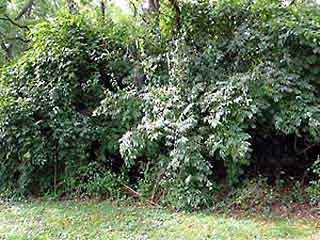 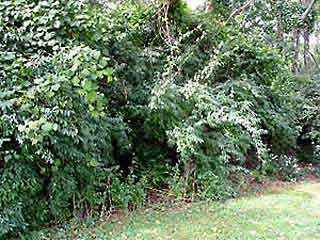 |
Several years ago I noticed that the wildflowers had disappeared from our little woods. The ground used to be covered in the spring with spiderwort, toothwort, wild blue phlox, wild geranium, some bloodroot, and occasionally Solomon's seal. All that remained was a patch of toothwort that bloomed where we had taken out some honeysuckle crowding the patio. To walk through the woods I had to break through thick, broken brush from the honeysuckle bushes. Then, in March, 2002, I took a class in wildflowers from a biology professor who convinced me to eliminate invasive plants like honeysuckle and garlic mustard that crowd out native plants in our woodlands. This is how the jungle-like lower edge of my woods appeared last summer (2001) before I started my project. |
 |
This bank was completely cloaked in honeysuckle bushes over ten feet tall. The brush was so thick a redbud tree at the top of the bank was nearly choked to death. We decided to wipe out the alien honeysuckle and restore the woods. It took two men about six hours to cut down the bushes and chip the wood. I brushed every stump with Roundup, so they wouldn't re-sprout. I stopped counting at 400. Some of the stumps were almost a foot across. We planted ten little dry-root redbud trees on the slope and so far they are flourishing. |
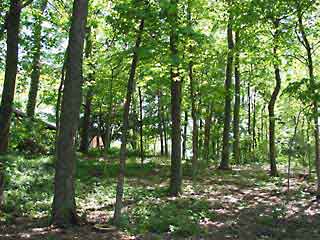 |
The woods used to begin at the bottom of this hill. We had the kids' swing set, a sandbox and a little playhouse here under the trees. The honeysuckle bushes invaded the grassy area and extended the woods by at least fifteen feet behind where I stood to take this picture. Looking up from the lower edge of the woods, you can now see through to the top of the hill. At the lower right I marked the beginning of a path to wind up through the woods. |
 |
Midway up the hill the path winds back toward the house. Out of the picture to the far right is a small sunny area next to the fence where the utility company trimmed the trees. This summer I planted black-eyed Susans and other sun-loving plants, hoping to get a mini-prairie going there. I've found evidence that deer jump the fence around our yard and stroll through our tiny woods. |
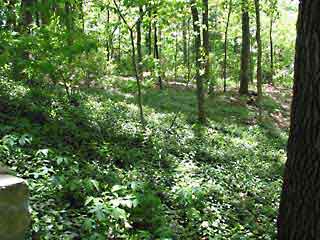 |
To the left of the path is a large area of groundcover that includes native Virginia creeper. There used to be a small grassy patch here that was hard to mow and didn't do well in the shade. I started some periwinkle and euonymous and they seemed to disappear under the honeysuckle. I had no idea they were flourishing until we took the honeysuckle out. I intend to keep it this way for now, even though they aren't native plants, at least until I see what comes up next spring.
|
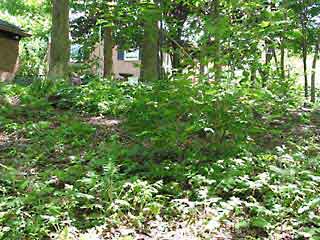 |
Looking toward the patio you see large-leaved waterleaf in the foreground. The entire woods is filled with it in the spring. Above and to the left is an area of Virginia bluebells and mayapples that I started years ago next to the patio. I worked two years--including part of this spring--to pull out all the garlic-mustard throughout the woods. I'm still pulling up seedlings from the garlic-mustard and honeysuckle bushes and will probably have to do it for years to come. |
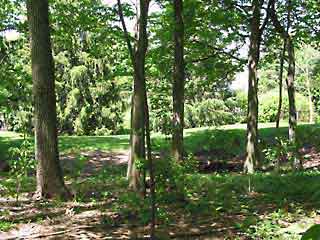 |
From the middle of the hill looking down you can see the grassy area of the side yard. When we first moved here, the kids could go sledding down the steep hill from the top of the woods to the bottom of the yard. The trees are second-growth, so most are very tall with narrow crowns. I'm learning to identify them and find we have a great variety. More on this later.
|
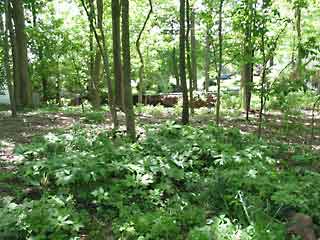 |
Looking across the stand of mayapples and bluebells from the patio, we can see our neighbors for the first time in years. We were concerned about losing the privacy of the thicket, but have enjoyed renewing acquaintance with our neighbors. Another plus is that we can now enjoy the antics of the critters in the woods--squirrels, rabbits, chipmunks and birds--even more as they scamper through the woods.
|
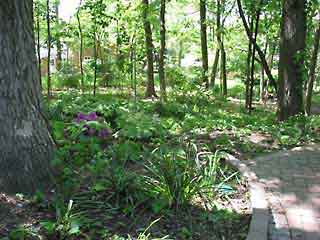 |
As you can see from the corner of the patio, the woods comes right up to the patio. This area encompasses a small wildflower garden I've been tending for years. I even managed to get a jack-in-the pulpit to come up, but it never fruited until this year. I moved some of the bluebells and mayapples into other parts of the woods this spring after they bloomed and planted some wildflowers I got at the Cox Arboretum's annual wildflower sale.
|
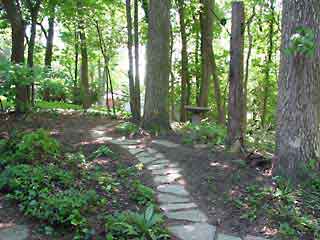 |
At the top of the woods I laid a stone path from the patio into the woods. Where the stones stop, the mulched path begins. Out of sight to the left I started a compost pile that is just about ready to use. My "five-year plan" is to keep my woods natural, but I will be adding some non-native plants that are often found in woodland settings, such as Winter Aconite and Snowdrops. I'll post pictures on the changes of seasons and the flowers and trees, which you can access from the links below. I've already put up pictures of some of the plants I've photographed this year and last in other places.
|
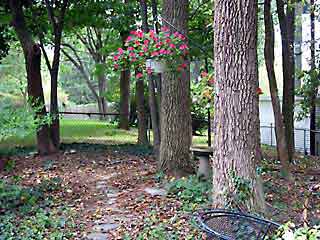 |
The kitchen window overlooks this path into the woods. I've planted shooting star, Lenten rose and columbine plants beside the path. The hook that holds the hanging basket is used for the bird feeder and to the right of it is another for the squirrel feeder. This is a very busy place in the fall and winter months. Our little woods is home to 8-10 gray squirrels, two of them albinos. We've recently discovered that raccoons visit our bird bath at night. It's amazing how much wildlife there is in this small woods.
|
| The ground is so bare after the summer drought. Early on the Virginia waterleaf makes the woods look very green. I'm hoping the bluebells and mayapples I transplanted will take hold on this hill. The area at the lower end of the woods gets some water from our lawn sprinkling system, so I'm putting in some moisture-loving plants down here. You can see the small dogwood at the left edge of the picture and a viburnum at the lower left.
|
|
| This is the area that surprised me the most. I cleared nearly all the plants off it--mostly garlic mustard and yellow oxalis. There is still a lot of oxalis, but a lot of white snakeroot and yellow ragwort have appeared. A few flower-of-an-hour plants popped up, spring violets are spreading and for awhile there was a mint-type plant I haven't identified that made a beautiful green ground cover throughout the summer. These aren't the most fabulous wildflowers, but the thing that amazes me is that none of these plants were there where the honeysuckle grew. So maybe I'll get some real thrills next year when the spring ephemerals bloom.
|
|
| Wildflowers | Home Return to Top |
| email:Nita Leland | © 1998-2012 Nita Leland All Rights Reserved. | Webmaster:Amy Elieff Brown |